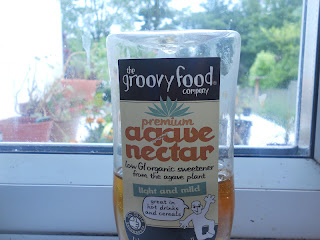Ingredient of the month 10: Agave Nectar
 |
| This natural sweetener is really good for baking with... |
As promised when I wrote about food trends for this year, here is another natural sweetener, and one I've been using for well over a year now. I find that in baking, if I substitute 200ml of agave nectar for the 200g sugar in my basic eggless cake recipe and add it to the wet ingredients I get a really soft and fluffy textured cake that is still sweet but without the harsh qualities of sugar, if you know what I mean.
Most agave nectar comes from Mexico or south Africa, and is made by heating the juice from the leaves of agave plants, to produce light, amber or dark agave nectar. (You can also get raw agave nectar, produced by using enzymes rather than heat.) The darker the agave nectar, the more strongly caramel-like the taste.
Why is agave nectar better for you than sugar? -Well, it contains mainly fructose rather than sucrose, which is assimilated less rapidly by the body, so you don't get a sugar " high" (followed by a "low"). It has a far lower glycaemic index than sugar. Also, agave nectar is about 1.4 times sweeter than sugar, so in theory you don't need as much (thereby saving calories, as agave nectar has a similar calorie count to sugar).
Having said this, though, I often use agave nectar as as straight swap for sugar in baking, which seems to work very well. It dissolves easily, even in cold liquids, so it's a good addition to cheesecakes, flapjacks, iced desserts and drinks. The amber and dark agave nectars are great on porridge or pancakes, too. Many vegans use them in place of honey.
What about nutritional benefits? Well, being a refined food, any minerals and suchlike that agave might contain are destroyed in the processing. But at least it's not bad for you. (One caution though: foods like agave which are high in fructose should not be taken in excess as fructose can only be broken down by the liver, so too much will put a strain on that organ.)


Comments
Post a Comment
You are welcome to comment- feedback from you really helps me to decide what to post, and I love hearing from you- thanks :)